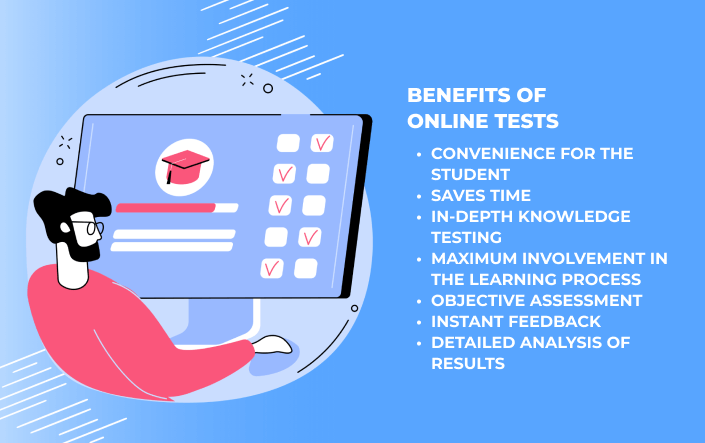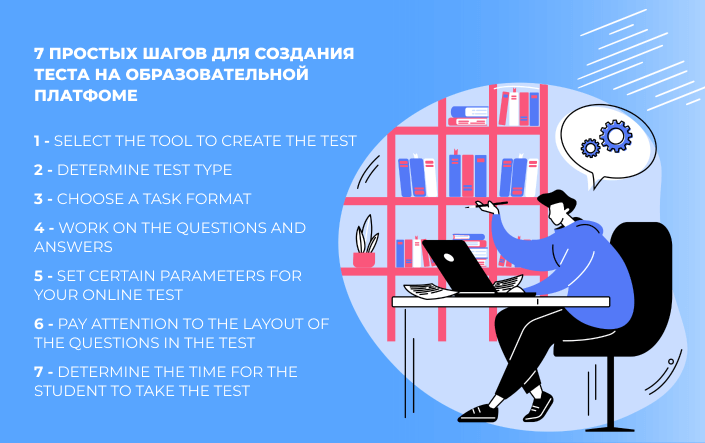If you expect to test the e-course users' skills, you should create and launch an online test. But already at the stage of its development, many questions arise: how many questions to add to the test, what question formats to choose, what score to set for passing the test, etc. We are ready to answer all these questions in our guide on creating a test on the eLearning platform.
Benefits of Online Tests
Each eLearning platform offers an easy-to-use test builder. They have different features and functions that tutors and learners can leverage. But they all have common advantages:
Convenience for the Student
Each learner can take tests at any convenient time on the online platform. It is crucial for cases when a student takes an asynchronous course and determines the lesson schedule for himself independently.
Saving Time
Online tests allow the course creator to quickly check the assimilation of knowledge of students through automatic testing. It makes the entire process easier, faster, and cheaper.
Deep Knowledge Check
Each test uses different question formats, so students cannot answer randomly and shift to the following session.
Maximum Involvement in the Educational Process
Modern eLearning platforms allow you to create an online test that increase students' motivation and improve the quality of knowledge testing.
Objective Assessment
Automatic marking of answers eliminates the human factor and the influence of personal interactions between tutors and learners.
Instant Feedback
Modern eLearning platforms allow testing customization, so each user gets an explanation when choosing the wrong answer.
Detailed Analytics
Teachers get access to the test result statistics. It allows you to focus on the results of specific students or make changes to the course program.

7 Easy Steps To Create a Test on the Online Platform
And now, it's time to familiarize yourself with the process of creating online tests. Here is a step-by-step guide.
Choose a Tool To Create a Test
In our case, it's pretty simple. LMS Kwiga has a built-in test builder that allows you to create a list of tasks in different formats.
Determine the Testing Type
There are two types of tests in online courses:
- Interim. It strives to consolidate the student's knowledge. Thus, they involve more time and attempts to choose the correct answer.
- The final test. The test has a precise time limit and only one attempt to give the correct answer.
Before choosing the testing type, you should review the course program and consider the test purpose.
Choose a Question Format
Tests in the eLearning courses provide various formats of questions. Here are the most widespread types of questions:
- The choice of one answer — users have to choose only one correct answer.
- A choice of multiple answers — the principle is similar to the previous type, but here you should choose more correct answers from the list. This question format is more complex and requires precise expertise in the domain.
- True/False — the user determines the truth or falsity of the statement.
- Brief answer — the user has to enter the answer in text or number format. It is impossible to choose a random variant here.
- Order task — the learner has to put the options in the correct order. Often, this format requires reconstructing the sequence of historical events or the number arrangement.
- Fill in the blanks — this format involves tasks concerning certain concepts or patterns. The user needs to fill in the gaps by dragging words or parts of phrases from the list or typing the answer.
- Conformity — users have to connect paired words, pictures, or phrases. They can also add deliberately incorrect options to add some complexity to a question.
The complexity of testing depends on the selected number of formats. However, it would be best not to make the test too complicated.
Work on Questions and Answers
The online test effectiveness is affected by the correct wording of tasks. Remember that learners cannot look for help when doing them. And if they do not understand the subject matter, they will not know how to choose the correct variant. Therefore, you should carefully work on questions and answers. Here are our tips:
- Keep questions simple and straightforward. Ideally, it is a sentence of up to 20 words without complex speech patterns.
- The text should not have repetitions or mutually exclusive phrases, which applies primarily to "True/False" tasks. Otherwise, students may not understand the question.
- Mention exact facts. Online tests do not tolerate approximation.
- Open-ended questions should start with the words "what," "why," "how much," etc.
- Think carefully about answer options that fit the structure but are distracting.
- Avoid using "all of the above" and "none of the above" response options.
- As for tasks that ask for filling in gaps, do not use options of accidentally writing a lowercase letter instead of a capital one or adding extra letters. Therefore, the answer may be correct, but the system will not automatically count it.
All these rules are critical to creating clear assignments that assess student knowledge properly.
Set Specific Parameters for Your Online Test
The choice of parameters depends on the specific purpose of testing: to consolidate the acquired knowledge or to check the material assimilation. In any case, course creators set four essential parameters.
Passing Grade
When working on an online test, you may doubt the passing score. Thus, we cannot provide some universal tips, so it is better to start from the course goal.
For instance, you are developing an intermediate test on web design basics. Its main goal is to consolidate the material learners covered and fill in knowledge gaps. The optimal passing score is 70 out of 100 possible.
If you are testing the healthcare worker's knowledge, you can set 100 points out of 100. The reason is simple: the patient's fate depends on the doctor's actions. And any mistake is high-cost.
Set Specific Parameters for Your Online Test
As for the test volume, teachers often ask to answer 25 to 30 questions. However, experts recommend making the total task pool somewhat larger (from 75 to 120 items). In this case, the system will automatically select questions from the list and offer them to students. Such tests will be unique for each student and reduce the possibility of cheating.
Number of Attempts to Answer
If you plan to conduct a final test, give only one attempt to your users. It is complicated to answer randomly, but learners will receive more objective marks.
Branching
This parameter is vital for interim testing events. The essence of branching is simple: when students make a mistake, they get an explanation of the correct answer. If they choose the right option, they will move on to the following question. This approach helps users to perceive the eLearning material better.
Take Some Time To Create a Perfect Design
Not every student enjoys passing the test. And for specific users, this event is akin to a nightmare. But every course creator can turn this process into a more enjoyable and exciting pastime. Just work hard on the issues and add some interactivity. There are two ways to ensure this:
- Visual design. Choose a new layout for each question (a unique font or background color).
- Voice acting. Add a pre-recorded file or record audio directly in the Kwiga LMS. Then, you can use the internal features to cut extraneous noise from the recording.
With the right approach to interactivity, you can add exciting tasks to increase testing efficiency.
Determine the Time Limitation To Pass the Test
Another major factor is the time constraint. You should set it so that learners do not have any options to cheat. On average, course creators set a time limit of 10 to 30 minutes. However, it depends on the volume and complexity of the test.
It is enough to solve all the tasks. After all, if learners understand nothing about a topic, then cheat sheets will not help them.

5 Tips for Creating a Test on an Online Course Platform
If you want to create your first online test easily and quickly or improve existing ones, you should follow some rules. Here are five practical tips for working on online testing:
No to the Complex Wording
Questions and possible answers should be clear and understandable. Thus, forget about no ambiguities, complex turns of speech, and mutually exclusive phenomena. A perfect length of a regular test is 20-25 questions.
Originality and Diversity
The more fascinating and diverse questions users answer, the more pleasure they will get. Moreover, different task formats allow you to assess the learner's expertise better.
With an online platform, you can add many tasks. Then, the platform automatically generates a unique set for each user. It reduces the possibility of cheating and increases assessment objectivity.
30/40/30 Rule
This rule shows the optimal ratio of question formats, which makes testing effective. The test should have 30% of questions with one correct answer, 40% - with several correct answers, and 30% - with open-ended questions (detailed answers to the question or practical task).
Feedback
Classic school or university tests lack feedback. Remember how you received a piece of paper with incorrect answers crossed out? You probably wanted to ask the teacher, "Why do you think so?".
Testing in an online course is almost similar to a traditional one, but students can get quick feedback on all assignments. For example, the system automatically displays an explanation of correct answers. Therefore, students can easier understand why they answered incorrectly.
Optimal Number of Tasks
If you choose a massive set of questions, you will scare off students and quickly demotivate them for further learning. Thus, choose the optimal test volume: 10-20 questions for a regular test, 30-50 - for an intermediate one, and 50-60 - for a final knowledge test. This approach will allow you to evaluate expertise qualitatively and not scare users.

Conclusion
Online tests are an appropriate way to measure knowledge and help students better understand the course material. And test automation makes the process less routine, and the results become more objective.
We hope that this article became helpful to you. If you want more information about creating online tests on the educational platform, leave them in the comments. The best questions will become topics for our new materials.


